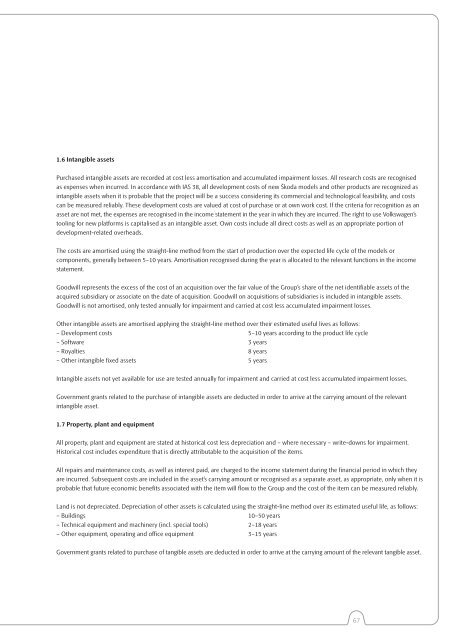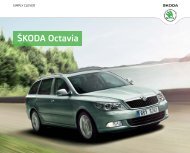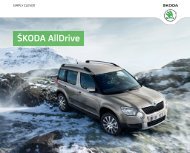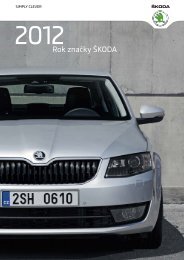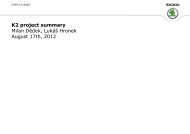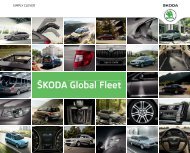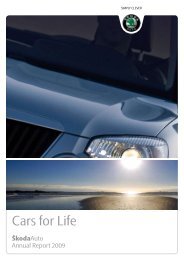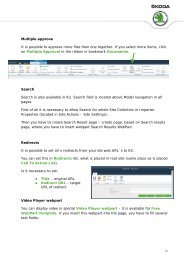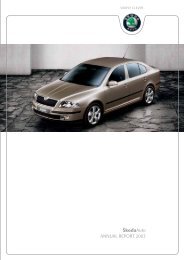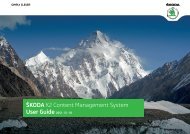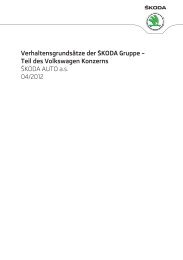Å kodaAuto ANNUAL REPORT 2006 - Skoda Auto
Å kodaAuto ANNUAL REPORT 2006 - Skoda Auto
Å kodaAuto ANNUAL REPORT 2006 - Skoda Auto
Create successful ePaper yourself
Turn your PDF publications into a flip-book with our unique Google optimized e-Paper software.
1.6 Intangible assets<br />
Purchased intangible assets are recorded at cost less amortisation and accumulated impairment losses. All research costs are recognised<br />
as expenses when incurred. In accordance with IAS 38, all development costs of new Škoda models and other products are recognized as<br />
intangible assets when it is probable that the project will be a success considering its commercial and technological feasibility, and costs<br />
can be measured reliably. These development costs are valued at cost of purchase or at own work cost. If the criteria for recognition as an<br />
asset are not met, the expenses are recognised in the income statement in the year in which they are incurred. The right to use Volkswagen’s<br />
tooling for new platforms is capitalised as an intangible asset. Own costs include all direct costs as well as an appropriate portion of<br />
development-related overheads.<br />
The costs are amortised using the straight-line method from the start of production over the expected life cycle of the models or<br />
components, generally between 5–10 years. Amortisation recognised during the year is allocated to the relevant functions in the income<br />
statement.<br />
Goodwill represents the excess of the cost of an acquisition over the fair value of the Group’s share of the net identifiable assets of the<br />
acquired subsidiary or associate on the date of acquisition. Goodwill on acquisitions of subsidiaries is included in intangible assets.<br />
Goodwill is not amortised, only tested annually for impairment and carried at cost less accumulated impairment losses.<br />
Other intangible assets are amortised applying the straight-line method over their estimated useful lives as follows:<br />
– Development costs 5–10 years according to the product life cycle<br />
– Software 3 years<br />
– Royalties 8 years<br />
– Other intangible fixed assets 5 years<br />
Intangible assets not yet available for use are tested annually for impairment and carried at cost less accumulated impairment losses.<br />
Government grants related to the purchase of intangible assets are deducted in order to arrive at the carrying amount of the relevant<br />
intangible asset.<br />
1.7 Property, plant and equipment<br />
All property, plant and equipment are stated at historical cost less depreciation and – where necessary – write-downs for impairment.<br />
Historical cost includes expenditure that is directly attributable to the acquisition of the items.<br />
All repairs and maintenance costs, as well as interest paid, are charged to the income statement during the financial period in which they<br />
are incurred. Subsequent costs are included in the asset’s carrying amount or recognised as a separate asset, as appropriate, only when it is<br />
probable that future economic benefits associated with the item will flow to the Group and the cost of the item can be measured reliably.<br />
Land is not depreciated. Depreciation of other assets is calculated using the straight-line method over its estimated useful life, as follows:<br />
– Buildings 10–50 years<br />
– Technical equipment and machinery (incl. special tools) 2–18 years<br />
– Other equipment, operating and office equipment 3–15 years<br />
Government grants related to purchase of tangible assets are deducted in order to arrive at the carrying amount of the relevant tangible asset.<br />
67


